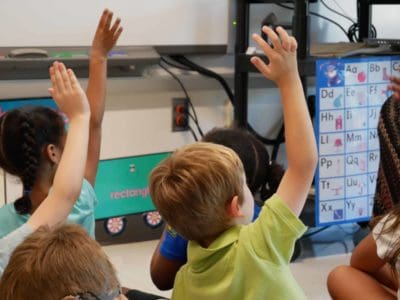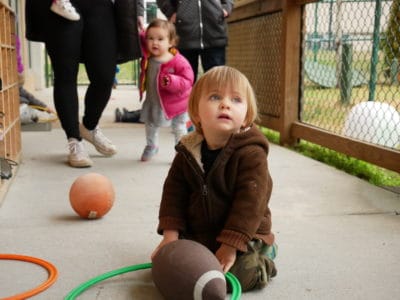

Remote learning presents challenges, especially for the youngest learners. As many districts choose to start the fall semester virtually to reduce the spread of the coronavirus, a survey of NC Pre-K teachers provides insights into how remote preschool went in the spring — and what can be done better.
Robert Carr, the report’s lead author and research scientist at Duke University’s Center for Child and Family Policy, said the findings reflect the reality that remote learning misses “the most essential aspect of an early childhood education:” warm, everyday, in-person interactions between children and teachers.
“Teacher-child interactions are the stuff of early childhood education,” Carr said. “Remote learning was not a substitute for everyday, close, one-on-one teacher-child interactions.”
The majority of teachers in the survey identified social and emotional development as the most difficult in a set of early learning domains to teach remotely. About a third of 4-year-olds enrolled in the state’s public preschool program received daily remote learning services from their lead teachers during the spring’s closures. Carr said these services might not have been direct contact with the child, and could have been things such as a call or text with a parent.
Lead teachers said another 58% of children received weekly services and 4% received less-than-weekly services. The state’s remote learning guidance for NC Pre-K teachers requires real-time contact with children and a parent or caregiver twice a week.
Remote preschool ‘not a thing that happens’ — Some successes
Carr said the survey responses do show some successes of the program — which targets “at-risk” children, with eligibility mostly dependent on income — during an unprecedented transition.
“This was a different thing that teachers were doing that had never really been done before,” Carr said. “Distance learning for preschool is not a thing that happens.”
The study was funded by the Department of Health and Human Services (DHHS) and designed and administered in collaboration between DHHS and the Center for Child and Family Policy. From May 26 to June 15, 89% of lead NC Pre-K teachers and 68% of assistant teachers responded, from sites in both public elementary schools and private child care facilities. The majority of lead teachers who responded (76%) said they felt able to effectively deliver remote learning services.
And lead teachers’ responses showed they stayed in some sort of contact with nearly all of their students (96%) as the majority of their classrooms (89%) went online.
Compared with the results of a national survey of parents of children 3-5 years old from the National Institute of Early Education (NIEER), released last week, Carr said this is a win. The NIEER report found that preschool enrollment nationwide dropped from 60% to 30% during the pandemic.
Public funding helps stability
Carr said the public nature of NC Pre-K helped keep teachers employed and students enrolled.
The NIEER report that showed enrollment cut in half looked at young children in a variety of settings, including public preschool programs and private child care facilities. Carr said the public funding structure of a program such as NC Pre-K has given the program stability that much of the child care industry has lacked in recent months.
“I think it’s quite remarkable that we didn’t see the type of full-on classroom closures and programs completely going out of business that we are seeing with the broader child care trend,” he said. “Programs that serve kids birth to age 3 operate on a very different funding stream … on parents paying month by month.”
About 43% of North Carolina’s licensed child care facilities closed in March and April. In June, 34% of centers and home-based providers remained closed. Child care directors and early education advocates have warned that many programs, which were largely relying on private-paying parents, are at risk for staying closed permanently without public investment. In 2017, about half of children being served by NC Pre-K were at private facilities.
More on child care during COVID
Meanwhile, NC Pre-K salaries were covered with state funding, and DHHS continued to pay NC Pre-K private sites their reimbursement rates based on pre-pandemic enrollment.
Ninety-eight percent of lead teachers and 93% of assistant teachers remained employed and delivered remote learning services. As previously mentioned, about 4% of students enrolled before the pandemic did not receive any type of remote learning services.
Parents lacked time
The largest barrier that responding teachers reported for families to engage in remote learning was simply lacking the time, with 43% of lead teachers saying time was the top barrier and 22% saying access to technology was the largest.
Carr pointed to the NIEER study, which asked parents about specific at-home learning activities and found parents engaged in some teaching activities less often under quarantine.
“Even though time that parents are spending interacting with their kids at home is less, the quality of those interactions can be improved,” he said.
Drawing from both studies, Carr said he thinks preschool teachers have a role in helping parents interact in meaningful, in-person ways with their children, from having a conversation at breakfast to reading at night to managing conflict.
“It’s the everyday stuff that matters,” he said.
He said family engagement — already a core piece of NC Pre-K’s normal approach — should be a focus of preschool teachers’ remote learning strategies.
“It’s not just providing direct services to children, it’s supporting parents in working with their children,” he said.
Teachers need remote-specific training
Carr also recommends teachers receive formal guidance in adapting curriculum to remote learning, training on video communication platforms, and guidelines to ensure contact with children and families at least twice a week.
“We need to seriously think about what it means to deliver remote learning over the phone,” Carr said. It’s obvious it won’t be the same as in-person instruction, he said, but teachers need support in maximizing it.
He said teachers reported video communication as the most effective way to deliver remote learning, yet most said they only sometimes were using video platforms.
The report recommends supports for teachers to contact students at least twice a week, adding that students who need the most support should be prioritized for daily services, such as children with special needs or English-language learners. Parents’ schedules and desires, Carr said, should also be considered.
“For this daily interaction, teachers should be thinking thoughtfully about who to target their efforts to,” he said.







